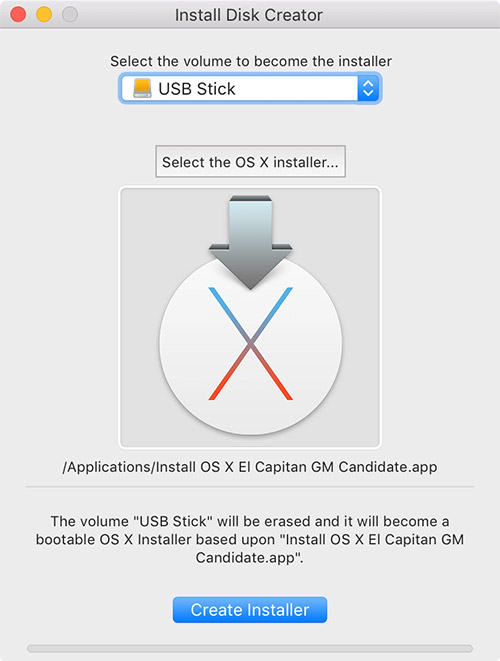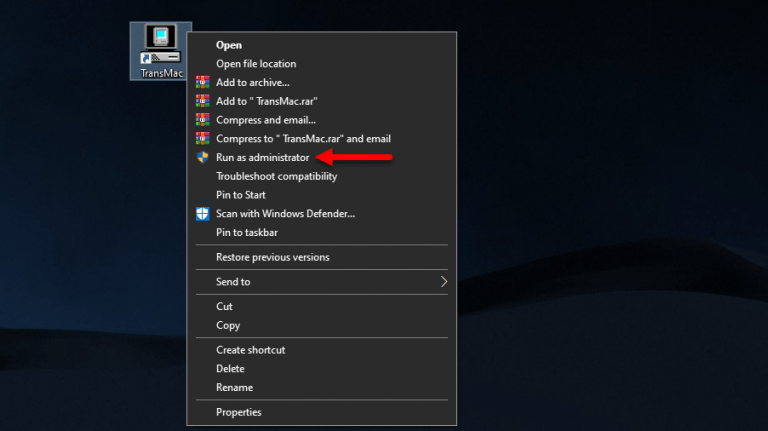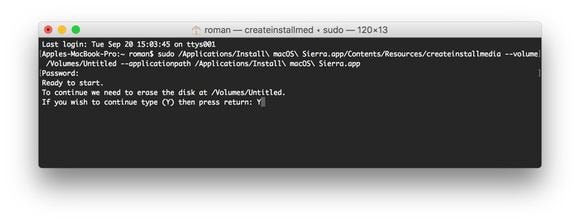

- #Install disk creator macos install#
- #Install disk creator macos pro#
- #Install disk creator macos iso#
- #Install disk creator macos mac#
- #Install disk creator macos windows#
Then I create the sources folder and copy all files from sources with the exception of install.wim: Prepare to split install.wim I typically start by copying all separate files and folders, except for the sources folder:

We will take care of that later so for now, copy all remaining files to the USB drive using Finder. As you can see, the sources folder contains one large file: install.wim which is over 4GB and will not fit on the FAT32-formatted USB drive:
#Install disk creator macos iso#
Once the ISO file is download as well, double click the ISO file to mount it. Copy all smaller files to the USB driveĪfter the previous step, our USB drive is prepared. Finally click “Erase” to complete the process. In the dialog, enter a name for the drive (WINUSB here), choose to format as “MS-DOS (FAT)” and “Master Boot Record” as scheme. Then, on the left side, select your USB drive from the list and click Erase on the top right menu. In Disk Utility, choose to show all devices:
#Install disk creator macos mac#
Insert the drive in your Mac and start Disk Utility. While the ISO is downloading, we can prepare our USB drive. iso file on your Mac: Prepare the USB drive
#Install disk creator macos windows#
When you open this link on macOS, it should show you the ability to download the ISO rather than the Media Creation tool, which is shown when opening the same on a Windows-based PC.Ĭhoose for Windows 10, then select the preferred language, go for the “64-bit Download” and wait for the download to complete to get the. Let’s start by downloading the ISO from Microsoft.
#Install disk creator macos install#
In case you’re looking for the instructions to create a bootable USB drive to install Windows 11 instead, have a look at the following article: Download the Windows 10 ISO

Create bootable Windows 11 installation USB To overcome this, we will need to use a tool, Wimlib, which is able to split this file in two parts. FAT32 has a file size limit of 4GB while the installation ISO now contains one file that is larger. The main reason for this is because macOS supports only FAT32 as filesystem that is compatible with Windows (and ExFat but that causes issues to boot from). You might also throw a few bucks to Guillaume for saving you some time.Unfortunately, since some time, it became a bit more complicated to create this USB drive from macOS. Things should go smoothly if you do a little research and read the instructions. My rule is this: make sure you backup everything before you install anything. Whether you want to restore your Mac to factory settings or downgrade to an earlier macOS version like me, there are many advantages to creating a bootable installer drive. I created a handy Mountain Lion boot disk on a USB thumb drive to downgrade the aforementioned Mac Mini from Yosemite. DiskMaker X is available in Lion, Mountain Lion, Mavericks, Yosemite, El Capitan, and Sierra macOS versions. This application simply finds the original installer on your computer, then creates a bootable installer on most any external drive (USB, FireWire, or Thunderbolt), 8 GB or larger. MacWorld has published easy-to-use step-by-step tutorials, one of which turned me on to DiskMaker X. Disk Creator and the standard Apple-provided Disk Utility application can also be used. If you’re familiar with the Teminal application, you can use the createinstallmedia command to generate a boot disk. If you think I’m being cheap, try to remember how much we generally get paid for our work, and understand that I’d prefer spending my money on mics, not Macs.ĭowngrading to an earlier version of macOS isn’t a simple thing for the layperson, but the basic requirement is that you need to create a bootable installer from a macOS image file. In a desperate last ditch effort to steal time from “progress,” I recently purchased a refurbished, downgradeable Mac Mini with a faster processor and more RAM than a new Mac Mini that would have cost me twice the price. For the time being, I’m gambling that a brand-new Mac might just as easily fail as a used one might.
#Install disk creator macos pro#
In my opinion, macOS 10.8.5 running Pro Tools 10.x is stable and “rock solid.” Some of us put off inevitability to maintain productivity, but eventually “progress” (be it for our own benefit or not) will move us forward.


 0 kommentar(er)
0 kommentar(er)
